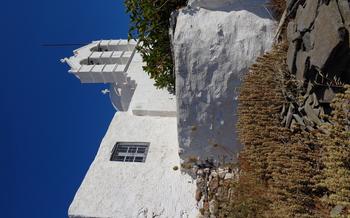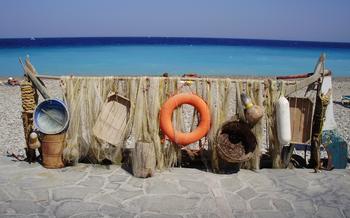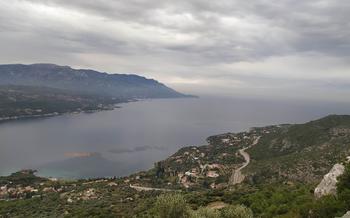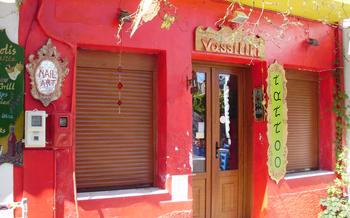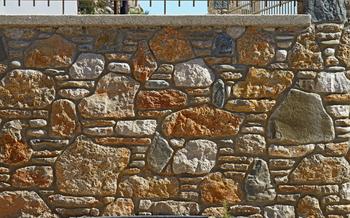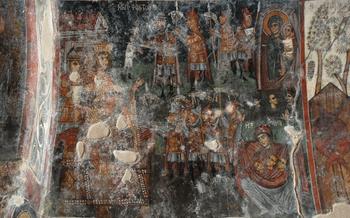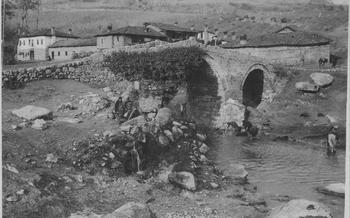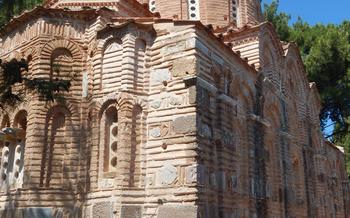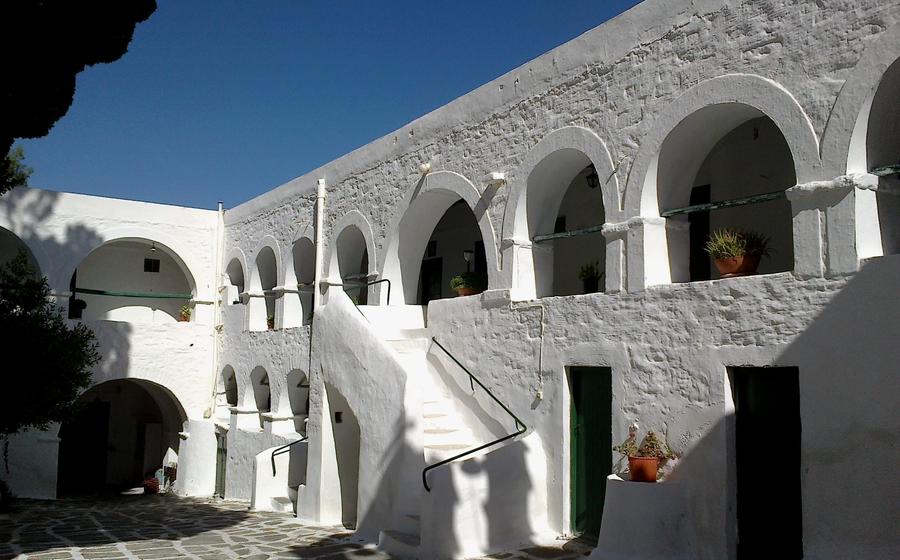
Longovarda Monastery
- Explore the Rich History of the Longovarda Monastery
- Architectural Marvel
- Religious Significance
- Cultural Heritage
- Breathtaking Views
- Guided Tours
- Pilgrimage Site
- Iconography and Art
- Peaceful Retreat
- Local Traditions
- Photography Opportunities:
- Accessibility
- Seasonal Considerations
- Sustainable Tourism
- Insider Tip: Combine Your Visit with Lefkes Village
Explore the Rich History of the Longovarda Monastery
Founded in the 17th century by the Venetian noblewoman Fiorenza Sommaripa, the Longovarda Monastery is a testament to the island's rich historical tapestry. During the era of pirate attacks, the monastery served as a refuge for the local population, providing shelter and protection from marauding raiders. It also played a pivotal role as a cultural center for the island's Orthodox community, fostering religious devotion and preserving Byzantine traditions.
The monastery's architectural design reflects the fusion of Venetian and Byzantine influences, showcasing the island's diverse cultural heritage. The main church, with its intricate frescoes and delicate stone carvings, stands as a testament to the artistic prowess of the era. The surrounding buildings, arranged symmetrically around a central courtyard, exude an aura of tranquility and harmony.
In recent years, extensive restoration efforts have been undertaken to preserve the monastery's architectural integrity and historical significance. These efforts have breathed new life into the monastery, ensuring that its beauty and grandeur can be enjoyed by generations to come.
Architectural Marvel
The Longovarda Monastery stands as a testament to the architectural prowess of its creators. A harmonious blend of Venetian and Byzantine styles, the monastery's design showcases intricate details and decorative elements that captivate the eye. Explore the well-preserved structures, including the main church with its imposing dome and arched windows. Admire the bell tower, a beacon of faith that rises above the surrounding landscape. Take note of the intricate frescoes and stone carvings that adorn the monastery's exterior, each telling a story from the Bible or the history of the monastery. Inside, discover a world of Byzantine art, with stunning mosaics and icons that depict religious figures and scenes with vibrant colors and delicate brushwork. The monastery's architectural symmetry and harmony create a sense of serenity and awe, leaving visitors in wonder at the skill and devotion of its builders.
Religious Significance
The Longovarda Monastery holds immense religious significance as a center of Orthodox Christianity on Paros. It is dedicated to the Virgin Mary, and the monastery's most revered icon is the Panagia Longovarda, which is believed to have miraculous powers. Pilgrims from all over Greece and beyond visit the monastery to pay homage to the icon and seek blessings.
The monastery has played a crucial role in preserving and promoting Orthodox traditions and rituals. It has been a place of worship, prayer, and spiritual guidance for the island's Orthodox community for centuries. Religious festivals and celebrations, such as the annual Panagia Longovarda Festival, are held at the monastery, attracting a large number of faithful.
Visitors to the monastery can witness the vibrant religious life that takes place within its walls. They can attend religious services, such as the Divine Liturgy, and experience the spiritual atmosphere that permeates the monastery grounds. The Longovarda Monastery is a living testament to the deep religious faith and traditions of the people of Paros.
Cultural Heritage
The Longovarda Monastery has significantly contributed to the cultural heritage of Paros. It serves as a repository of Byzantine and post-Byzantine art, housing a collection of exquisite icons, manuscripts, and liturgical objects. These treasures offer a glimpse into the rich artistic and religious traditions of the island.
The monastery also played a pivotal role in education, serving as a school for young boys during the Venetian and Ottoman periods. It preserved and transmitted knowledge to future generations, fostering cultural continuity and intellectual growth on Paros.
Furthermore, the monastery has been instrumental in preserving and promoting Paros's cultural traditions and folklore. It hosts cultural events, exhibitions, and workshops that showcase the island's unique customs, dances, and music. Through these initiatives, the monastery contributes to the revitalization and transmission of Paros's cultural heritage to both locals and visitors.
Breathtaking Views
The Longovarda Monastery offers breathtaking views of the Aegean Sea and the surrounding landscape. Perched atop a hill, the monastery provides panoramic vistas that will leave you in awe. Gaze upon the picturesque villages of Paros, nestled amidst lush valleys and sparkling coastlines. Capture stunning photographs of the monastery's picturesque setting, with the vibrant blue sea as a backdrop. Enjoy the tranquility and serenity of the monastery's surroundings, away from the hustle and bustle of Paros's tourist hotspots. Let the panoramic views inspire your soul and create lasting memories of your visit to this hidden gem.
Guided Tours
To delve deeper into the rich history, architecture, and religious significance of the Longovarda Monastery, guided tours are highly recommended. Knowledgeable guides lead these tours, sharing fascinating stories and anecdotes that bring the monastery's past to life. Visitors can learn about the monastery's role as a refuge during pirate attacks, its dedication to the Virgin Mary, and its contributions to the cultural heritage of Paros. Guided tours offer a unique opportunity to discover hidden details and secrets that might be missed during an independent exploration, enhancing the overall understanding and appreciation of this remarkable monastery.
Pilgrimage Site
The Longovarda Monastery holds a significant place as a pilgrimage site for Orthodox Christians worldwide. Pilgrims from Greece and beyond flock to the monastery to pay homage to the revered icon of the Virgin Mary, Panagia Longovarda. The monastery's serene and spiritual atmosphere attracts those seeking solace and a deeper connection with their faith.
During religious festivals and celebrations, the monastery becomes a hub of activity as pilgrims gather to participate in ceremonies, light candles, and offer prayers. The annual Panagia Longovarda Festival, held on August 15th, is a particularly significant event that draws thousands of pilgrims who come to honor the Virgin Mary and seek her blessings.
The monastery's rich history, coupled with the devotion of pilgrims, creates a palpable sense of spirituality that permeates the air. Visitors can witness the deep reverence and faith of pilgrims as they partake in religious rituals, pray before the icon of Panagia Longovarda, and find solace within the monastery's sacred walls.
Iconography and Art
The Longovarda Monastery is a treasure trove of exquisite iconography and artwork that will captivate art enthusiasts and history buffs alike. The monastery's interior is adorned with intricate icons depicting religious figures and scenes from the Bible. Each icon tells a story and holds deep theological and historical significance. The vibrant colors, delicate brushwork, and artistic techniques used in these icons are a testament to the skill and devotion of the artists who created them.
Don't miss the stunning frescoes and mosaics that grace the monastery's walls and ceilings. These artworks narrate biblical events, saints' lives, and miracles associated with the Virgin Mary. Take time to study the intricate details and symbolism of these masterpieces, as they offer a glimpse into the rich artistic heritage of the monastery.
Exploring the iconography and art of the Longovarda Monastery is a journey through time, faith, and creativity. It's an opportunity to appreciate the beauty and depth of Orthodox Christian art and gain a deeper understanding of the monastery's spiritual and cultural significance.
Peaceful Retreat
Amidst the hustle and bustle of everyday life, the Longovarda Monastery offers a sanctuary of peace and tranquility. Escape the distractions of the modern world and seek solace within the monastery's serene walls. Let the tranquil atmosphere wash over you as you explore the monastery's tranquil gardens, where the sound of birdsong replaces the noise of traffic. Find a secluded corner to sit and contemplate, or simply wander through the monastery's peaceful grounds, allowing your mind to unwind and your spirit to be rejuvenated. The Longovarda Monastery is an oasis of serenity, inviting you to embrace the tranquility and find respite from the demands of the outside world.
Local Traditions
Discover the rich tapestry of local traditions and customs intertwined with the Longovarda Monastery. Delve into the enchanting stories and legends surrounding the monastery and its patron saint, Panagia Longovarda, passed down through generations. Participate in vibrant traditional festivals and events that take place at the monastery throughout the year, such as the annual Panagia Longovarda Festival. Immerse yourself in the cultural and religious practices that shape the very essence of Paros's local community. Embrace the opportunity to gain a deeper understanding of the unique traditions and heritage that make this island so captivating.
Photography Opportunities:
Capture the essence of the Longovarda Monastery's beauty and serenity through the lens of your camera. With its picturesque setting perched atop a hill, the monastery offers a myriad of stunning photo opportunities. Frame the monastery's imposing architecture against the backdrop of the shimmering Aegean Sea, creating a breathtaking composition. Explore the monastery's intricate details, from the delicate frescoes adorning the interior to the weathered stone carvings gracing the exterior. Experiment with different angles and perspectives to capture the monastery's unique character and charm. Take advantage of the monastery's panoramic views to create awe-inspiring landscape shots that showcase the surrounding natural beauty of Paros. Share your photographic masterpieces on social media, inspiring others to embark on their own journey to this hidden gem of the island.
Accessibility
Planning a visit to the Longovarda Monastery requires consideration of its accessibility and location. To reach the monastery, you can choose between various transportation options. If you prefer the flexibility of self-driving, renting a car is a convenient choice. Alternatively, you can utilize the local bus service, which offers regular routes to the monastery from various points on the island. For a more personalized experience, you can opt for a taxi service, which can be arranged through your hotel or a local taxi company.
Once you arrive at the monastery, be mindful of its operating hours, which may vary depending on the season. Typically, the monastery is open to visitors during the morning and afternoon hours, with a break in between. It's advisable to check the monastery's website or inquire with local tourism offices for the most up-to-date information.
When visiting the monastery, it's important to dress respectfully, as it is a place of worship and pilgrimage. Avoid wearing shorts, tank tops, or revealing clothing. It's customary to cover your shoulders and knees, and women may be required to cover their heads with a scarf or shawl.
By following these practical considerations, you can ensure a smooth and enjoyable visit to the Longovarda Monastery.
Seasonal Considerations
The ideal time to visit the Longovarda Monastery depends on your interests and preferences. If you seek a vibrant and lively experience, plan your visit during the summer months (June to August). This is when the monastery hosts religious festivals and events, attracting many pilgrims and visitors. The atmosphere is electric, and you'll have the chance to witness traditional ceremonies and celebrations firsthand.
However, if you prefer a more tranquil and serene experience, consider visiting the monastery during the shoulder seasons (spring and autumn). The weather during these months is still pleasant, but the crowds are smaller, allowing you to explore the monastery at your own pace and soak in its peaceful ambiance.
It's important to note that the monastery may have limited access or be closed during the winter months (December to February) due to weather conditions. Therefore, it's advisable to check the monastery's website or contact local tourism offices for up-to-date information before planning your visit during this time.
Sustainable Tourism
As a responsible traveler, it is essential to practice sustainable tourism when visiting the Longovarda Monastery and the island of Paros. Here are some tips to minimize your environmental impact and support local communities:
- Respect the Environment: Avoid littering and dispose of waste properly using designated bins or recycling facilities.
- Conserve Water: Water resources are precious on Paros, so conserve water by taking shorter showers and reusing towels.
- Support Local Businesses: Choose to stay in locally-owned guesthouses or hotels, dine at traditional tavernas, and purchase souvenirs from local artisans to support the island's economy.
- Reduce Plastic Waste: Bring your own reusable water bottle and shopping bags to reduce plastic waste.
- Respect Local Customs: Be mindful of local customs and traditions, and dress respectfully when visiting religious sites like the Longovarda Monastery.
Insider Tip: Combine Your Visit with Lefkes Village
Explore the Traditional Charm of Lefkes Village
Complement your visit to the Longovarda Monastery with a trip to the nearby village of Lefkes, a picturesque settlement nestled in the heart of Paros. Lefkes boasts a unique charm with its traditional Cycladic architecture, narrow cobblestone streets, and whitewashed houses adorned with colorful flowers. Stroll through the village's charming alleys, admire the beautifully preserved buildings, and soak in the authentic Greek atmosphere.
Panoramic Views and Local Delights
Lefkes is renowned for its breathtaking panoramic views of the surrounding landscape. As you wander through the village, you'll be rewarded with stunning vistas of rolling hills, lush valleys, and the sparkling Aegean Sea. Take a moment to pause and savor the tranquility of the village while enjoying the panoramic views from one of the many viewpoints.
Local Cuisine and Handicrafts
Lefkes is also a haven for foodies, offering a variety of traditional Greek tavernas and restaurants. Indulge in delicious local specialties, such as fresh seafood, succulent grilled meats, and homemade pastries, while enjoying the warm hospitality of the locals. Additionally, Lefkes is known for its vibrant handicraft scene. Explore the village's shops and boutiques to find unique handmade souvenirs, including ceramics, woven goods, and traditional embroidery.
A Perfect Day Trip Combination
Combining a visit to the Longovarda Monastery with a trip to Lefkes village makes for a perfect day trip on Paros. Immerse yourself in the island's rich history, culture, and traditions as you explore these two exceptional destinations. Whether you're seeking spiritual enlightenment, cultural immersion, or simply a relaxing day out, this itinerary promises an unforgettable experience.
